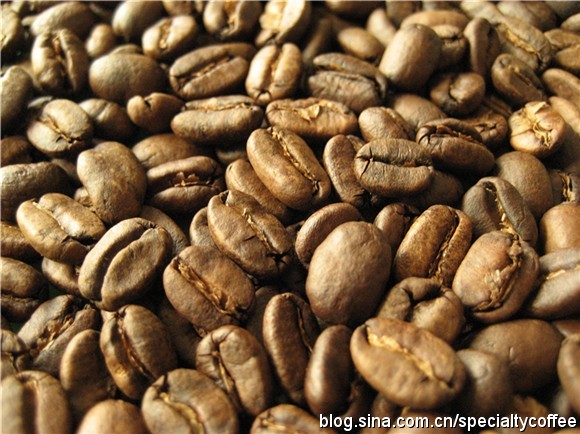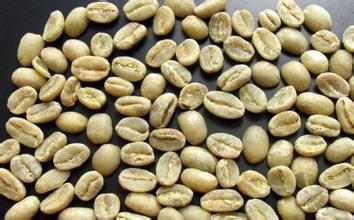Boutique coffee beans: the growth process of coffee beans in-depth understanding of the principle of coffee
A coffee tree can harvest 3-5 kg of fruit, and raw coffee beans account for 1. 5% of the fruit quality. Going from fruit to raw coffee beans is really a time-consuming and laborious task.

Arabian species, Robusta species, Libirian species
Arabian coffee accounts for about 2% of the world's coffee production. The plant is not suitable for high temperature, low temperature, more rain and less rain. Coffee beans are oval and flat, with high quality and rich aroma.
Robusta coffee has a strong bitter taste, no sour taste, and the flavor is not very good, so it is better to mix it than to use it alone. Often used to make frozen coffee, instant coffee, canned coffee. Suitable for planting in low-lying areas. The plant has the characteristics of strong disease resistance and fast growth.
Coffee grown in Liberia is of low quality and output and is only exported to Europe.
Flat beans and round beans
The ripe red coffee fruit has a multi-layered structure as shown in the picture. The pale green core with a little blue in the middle is the coffee bean.
In general, the core of a coffee fruit is oval. When two kernels are opposite to each other, flat beans are formed; sometimes single kernels grow to form round beans. The difference between the two kinds of beans is mainly in their taste.
From harvest to delivery
After the fruit is harvested, the skin and flesh must be removed. The endocarp and silver peel are removed to form coffee beans. There are two kinds of methods: drying (natural drying, non-washing) and washing.
Dry type, the operation is relatively simple, the harvested fruit will be spread on the dry ground and basked in the sun for a week or two. The sound of rattling can be heard when it is turned, which means it is dry. Then use the sheller to remove the pulp, endocarp and silver skin of the dried fruit.
This method gives coffee beans a soft sour taste and a mild bitter taste. This method is used in Brazil, Ethiopia, Yemen and other places. Disadvantages: vulnerable to weather, defective beans and foreign bodies are more likely to mix. Therefore, it is necessary to select it carefully before delivery.
In the washing type, the harvested fruit is poured into the sink, the floating matter is removed, the fruit in the water is moved to the pulp removal machine, the skin and pulp are removed, and then put back into the tank to remove the floating matter, the "core" in the water is poured into the fermentation tank, soaked for half a day or one day, the colloid on the surface of the fermented bean is removed, washed, dried or mechanically dried, and the endocarp is removed on the peeling machine to become commercial raw coffee beans.
The advantages of washing type: coffee beans have good luster, less foreign bodies, and slightly better sour taste. Colombia, Mexico, Guatemala and other countries have adopted this method. Coffee beans produced by washing account for almost 70% of the total output of coffee beans.
Sometimes poor treatment of fermentation time will produce fermentation odor and special sour taste; if handled well, it can form the personalized aroma of coffee beans.
At this time, the coffee beans can be sent to various places in sacks or in special containers.
Source: network
Important Notice :
前街咖啡 FrontStreet Coffee has moved to new addredd:
FrontStreet Coffee Address: 315,Donghua East Road,GuangZhou
Tel:020 38364473
- Prev

Boutique Coffee beans: the difference between Indonesian Mantenin Coffee beans and Golden Mantenin Coffee beans
Coffee gives you a luxurious bath. Among all the luxuries on the table, coffee is very precious. It inspires happiness but not drunkenness; it stirs up the heart, flows with pleasure, and never comes with sadness, tiredness, or weakness. Benjamin Franklin (1706-1790) when Benjamin Franklin wrote this famous quote, he may have thought that two hundred years later
- Next

Boutique coffee beans: Arabica coffee originated in Ethiopia
Ethiopia is a coffee-producing country with many legends, numerous varieties, rich orange fragrance and many fresh things, and there is no second country in the world that can compete with it. Ethiopia's long coffee history and cultural scenery have attracted a large number of explorers, archaeologists, botanists, anthropologists and writers to Fangze. The sleeping lion of Africa suddenly woke up after the millennium and burst into bursts.
Related
- Guji coffee producing area of Guji, Ethiopia: Humbela, Shakiso, Wulaga
- What is the most expensive variety of Qiloso in BOP multi-variety group?
- How to store the coffee beans bought home?
- Why are Yemeni coffee beans so rare now?
- Ethiopian Sidamo all Red Fruit Sun Sun Santa Vini Coffee beans
- SOE is mostly sour? What does it mean? Is it a single bean? what's the difference between it and Italian blending?
- Is Italian coffee beans suitable for making hand-brewed coffee?
- How to choose coffee beans when making cold coffee? What kind of coffee beans are suitable for making cold coffee?
- Just entered the pit to make coffee, what kind of coffee beans should be chosen?
- Can only Japan buy real Blue Mountain Coffee? What are authentic Jamaican Blue Mountain coffee beans?

